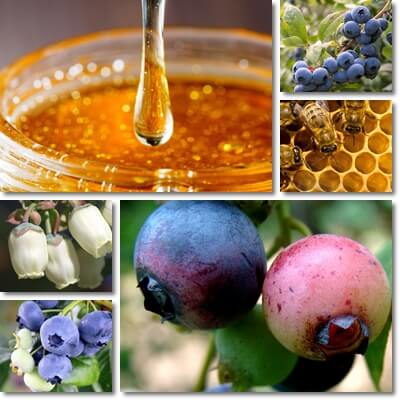Blueberry honey is a floral honey made from the flower nectar of American blueberry species. The amber honey variety is sweet and floral, with no pregnant flavors. Blueberry honey with a blueberry flavor is likely infused or flavored. Raw blueberry honey has immuno-modulating properties, local antiseptic properties, calms cough, soothes throat soreness and stomach upset in gastritis and acid reflux, and is good for skin care, with gentle exfoliating, brightening and tightening effects.
What is blueberry honey?
Blueberry honey is a honey variety made from nectar collected from blueberry flowers. Blueberry honey is made exclusively from the flower nectar of true blueberry species, that is, North American native blueberries, and will contain predominantly blueberry flower nectar.
The closely related European blueberry, the bilberry, can also be a source of honey, but there are no regulations as to what it should be called – blueberry, European blueberry or bilberry honey.
But since bilberries are primarily sourced from the wild from naturally-occurring plants, it is not an attractive honey variety for beekeepers, or at least not as attractive as honey produced from more well established cultivated crops such as blueberry, sunflower, rapeseed or others.

What is blueberry honey made from?
Blueberry honey is made primarily from flower nectar sourced from blueberry blossoms, with the help of special enzymes secreted by honeybees to process the nectar and make it into honey. Blueberry flower nectar is predominant, but the honey may contain small amounts of other flower nectars too. Because there are several different species of blueberry that serve as a nectar sources for honeybees, blueberry honey is not considered a monofloral honey by some despite at least part of it being sourced from a single species of blueberry plant.
What does blueberry honey look like?
Blueberry honey ranges in color from light amber to medium amber. To better put things into perspective, blueberry honey is darker than acacia, alfalfa and basswood (lime, linden) honey, but lighter than avocado, chestnut and manuka honey. Most blueberry honeys are somewhat of a sunflower honey color. The color variation can be explained by:
- The difference in nectar sources, that is, the fact that blueberry honey is made from the flower nectar of several different blueberry species, so not all blueberry honeys will look exactly alike.
- The ratio of blueberry nectar to other floral nectars – even monofloral honeys that are supposedly pure, made from just one nectar source, contain smaller amounts of other flower nectars because bees can’t be made to feed on just one flower source if there are other flowering plants in bloom at the same time and in the proximity of the flowering species intended for use to make honey. And since blueberries flower in spring over the course of several months (typically April-May), chances are there are other flowers to tempt honeybees.
- Time passed from production to harvesting to distribution to end consumer.
Is blueberry honey purple or blue?
There is this lingering expectation for blueberry honey to be blue or purple. It’s not. The flower nectar that blueberry honey is made from produces an amber-colored honey, while blueberry flower pollen (also present in the honey) is yellow, red-yellow and orange. Indeed, honeybees are known to feed on sweet, overripe fruit too, including grapes, serviceberries, blackberries and blueberries.
But even if the honeybees were to feed on blueberries, by the time the fruit would be ripe, the blueberry flowers would be long gone and the blueberry honey already produced and maybe even harvested. If your blueberry honey is blue or purple, or smells like blueberries, it’s likely a flavored or an infused blueberry honey, so check the label for useful information.
It’s true however that there is such a thing as blue honey, also called purple honey, but it’s produced from Japanese or Chinese arrowroot plants. The honey variety also has a grape-like flavor.

What does blueberry honey taste like?
Blueberry honey has a pregnant sweet taste with a light floral aroma. The honey is well-rounded, delicate and simply exquisite. It’s important to note that real blueberry honey should not have a blueberry taste, or tangy, fruity, berry flavors, or any aftertaste for that matter. If it has, then it’s likely infused or flavored blueberry honey.
The honey is viscous, moderately thick, with a smooth texture. Filtered blueberry honey is free of impurities or imperfections, while the unfiltered honey may contain beeswax, pollen and other particles.
You can get blueberry honey for sale on amazon, or check with local beekeepers starting mid-May to June after blueberry flowering has ended and the honey is ready to be harvested. Chances are, if blueberries are being cultivated extensively in your area, then someone is making blueberry honey too.
How to use blueberry honey
Blueberry honey is best eaten raw. You can eat it on buttered bread or plain bread, with sour yogurt, as a topping for nuts or soft cheeses, drizzled on biscuits or baked goods, with turmeric milk, coffee, tea or add it to a salad dressing. Cooking heat destroys the beneficial properties of honey and renders it about as healthy as regular sugar. High heat can make honey produce toxic byproducts.
Blueberry honey nutrition
Blueberry honey is over 3/4 sugar, primarily glucose and fructose, and, to a lesser extent, other sugars. Total content of sugar in honey is, on average, 82% to 86%. Other ingredients in blueberry honey include: water (water content of honey may range from 13% to up to 20%), pollen particles, beeswax particles, micronutrients (B vitamins, vitamin C, minerals such as calcium, copper, iron, magnesium, manganese, potassium etc.), amino acids, organic acids, volatile organic compounds, various enzymes and bioactive compounds (e.g. glucose oxidase, hydrogen peroxide).
Properties of blueberry honey
- Can be raw or pasteurized (raw is best, pasteurized destroys its therapeutic activity)
- Can be organic or not – requires certification (vs bilberry honey which is, in theory, organic)
- Varietal honey, floral
- Contains pollen – can cause allergic reactions
- Contains antimicrobial agents with antibacterial, antiseptic properties (e.g. glucose oxidase, hydrogen peroxide)
- Antiviral and antifungal properties
- Immune system modulating properties
- Tonic, energizing action
- Natural product, vegetarian, not vegan, gluten-free
Health benefits of blueberry honey
- Local antiseptic properties. Blueberry honey exerts local antiseptic properties thanks to a low moisture content, acidic pH and presence of antimicrobial agents (e.g. glucose oxidase).
- Immuno-modulatory properties owed to pollen present naturally in the honey which stimulates the immune system response.
- Antibacterial, antifungal and antiviral properties, but only in raw, unpasteurized blueberry honey.
- Benefits for respiratory infections. Raw blueberry honey provides antimicrobial agents (e.g. glucose oxidase, hydrogen peroxide) which reduce bacterial load, has a low pH and low water content and combats and prevents infection, exerting a local antimicrobial action with measurable benefits.
- Antioxidant properties. Volatile organic compounds, organic acids, trace nutrients such as vitamin C are biologically active and provide free radical scavenging properties, combatting, limiting and helping repair oxidative damage to cells.
- Soothes a sore throat. Raw blueberry honey has a low water content and viscous consistency and forms a protective coating over the throat lining, soothing irritation and reducing inflammation and associated pain and helping calm a sore throat.
- Calms cough. Taking raw blueberry honey or other raw honeys is an effective home remedy for cough, helping soothe and calm.
- Good for heartburn and acid reflux. Taking raw honey, blueberry or another variety, helps soothe irritation of the the esophagus lining caused by regurgitation of stomach juices in acid reflux disease, and protects from additional damage.
- Benefits for gastritis. Taking raw blueberry honey, or another variety, on an empty stomach in the morning can help soothe stomach upset in gastritis and promote healing.
- Benefits for wound healing. Applying some raw blueberry honey on a small cut, burn, insect bite or other type of small wound that has been previously cleaned can help prevent infection and promote faster wound healing.
- Raises blood sugar levels and helps combat hypoglycemia and associated side effects such as lethargy, lightheadedness, dizziness, low energy levels and fainting.
- Benefits for skin: applying raw blueberry honey on the skin exerts a gentle exfoliating effect, helping unclog pores, as well as minimizes pore appearance and tightens skin for healthier looking, younger skin appearance.
- Benefits for oily skin. Using raw blueberry honey on the face helps clear excess sebum without affecting the production of natural oils or drying out the skin.
- Benefits for dry skin. Using raw blueberry honey on the face nourishes and hydrates dry skin, and combats dullness.
- Good for uneven skin tone. If you have an uneven skin tone with redness, blemishes or acne scars, using raw honey such as blueberry helps you achieve a brighter, more even complexion.
Side effects, risks and contraindications
- Risk of allergic reactions and anaphylactic shock.
- High calorie content, can cause weight gain if eaten in excess.
- High sugar content, can raise blood sugar levels excessively.
- Risk of botulism in children under 1 year of age.
- Pollen contamination – may contain pollen from other floral sources.
